

If you have a Mac with Apple Silicone, press the power button and hold it for 5 seconds to get into macOS Recovery mode.If you have a MacBook with an Intel processor, press Command + R while your computer is rebooting to start the macOS Recovery mode.Restart your Mac from the macOS Recovery mode. However, there might be different reasons why you cannot remove the file. When you have closed the file or quit the app, you should be able to empty the Trash. You have to right-click on the icon in the Dock and select Quit from the provided options or press the Command+Q (“⌘ Cmd” + “Q”) shortcut. Note that it does not necessarily mean that you have quit it when you close the app’s window. All you have to do is close the file you want to delete or quit the app. Here we will provide the steps on solving those issues. Some of the most popular error messages that appear while trying to delete something are: the app is still running, or the file is in use. However, in the technology world, the issue is that there is always one more button to click. When working on a computer, you can always expect some bumps on the road.
#Mac empty trash how to#
Read also: “ How to delete messages on Mac.“
#Mac empty trash full#
If you are experiencing issues where your hard drive is full and want to delete files, you cannot transfer it into the trash or have a suspicious file that you want to get rid of immediately. Check off the box that says “Remove items from the Trash after 30 days.”ĭone, now your files will be automatically removed after being in the Trash for 30 days.Click on Preferences in the Finder’s menu on the top or use the Command+Comma (“⌘Cmd” + “,”) shortcut.All you have to do is follow the steps below: This part of the article will find information on making your Trash bin clean automatically after the file was there for 30 days. Read also: “ How to copy and paste on a Mac.“


 0 kommentar(er)
0 kommentar(er)
